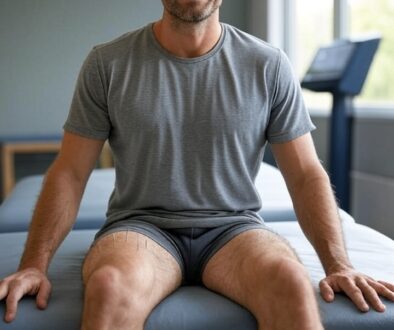Pelvic Floor or Junk Drawer?
Pelvic Floor or Junk Drawer?
Dr. Hannah Williams, PT
Pelvic Health Specialist
Everyone is familiar with the infamous junk drawer. Or cabinet, or whatever place of storage you use personally. Likely filled with random batteries, koozies, tape, super glue, half a piece of something you were planning on fixing, someone’s glasses and an old scratch off lotto ticket. Whatever we don’t want or feel we have time to deal with, we shove it in the junk drawer, to maybe sort out another day. Turns out our brain likes to do this as well with any stressors in life, physical, emotional or otherwise. All that jumbled mess turns our hips and even more so, our pelvic floor, the junk drawers of life. What the brain chooses to ignore or in many cases is unable to appropriately process ends up being stored in our pelvic floor, as dysfunction, pain, or tension (van der Kolk, 2014; Nickel et al., 2010).
Sounds suspicious? Let’s run through several scenarios and see if any resonate. Ever driven bumper to bumper and felt your shoulders touch your ears as the cars only seem to go slower? Ever have a frustrating conversation with a family member and find yourself rubbing out the headache you now have from clenching your jaw so hard? You can almost guarantee your pelvic floor muscles were also tense in both cases. When we experience chronic emotional, mental, or physical stress it can result in chronic pain anywhere in our bodies, most especially our pelvic floor, hips, or lower back (Chaitow & Lovegrove, 2012) .
Before we dive in, let me introduce myself! I’m Dr. Hannah, Physical Therapist at Peak Health and Performance. I specialize in post-operative, sports, tactical, and pelvic health rehabilitation and training. I am certified in trigger point dry needling and Neufit ESTIM, both of which are profound tools on the road to recovery and enhancing performance. Let’s return now to the pelvic floor.
Our pelvic floor tenses from stress because our nervous system is highly concentrated in that region due to the rich network of nerves needed to control our bowel, bladder, and sexual function (Wallace et al., 2019). In return, stressors in life overtime can lead to pelvic floor dysfunction, and hip or low back pain.
Pelvic floor tension occurs when the muscles in this area become overly tight, leading to various physical and emotional issues. It can result from various factors, including:
-
Chronic Stress: Emotional stress can manifest physically, leading to muscle tightness.
-
Injury or Trauma: Childbirth, surgery, or any trauma can impact pelvic floor muscles.
-
Posture: Poor positioning, especially from prolonged sitting, can contribute to tension.
-
High-Impact Activities: Certain exercises like jumping or lifting heavy may place excessive strain on a weakened, tight, or dysfunctional pelvic area.
The Ripple Effects of Tension on Health:
-
Physical Discomfort and Pain
Chronic pelvic floor tension can lead to a range of discomforts, including pelvic pain, lower back pain, and even hip pain. Individuals may experience pain during intercourse, urination, or bowel movements, which can significantly impact quality of life (As-Sanie et al., 2017).
-
Incontinence Issues
While many associate incontinence with weakened pelvic floor muscles, it can also result from excessive tension. The muscles may be so tight that they cannot relax to allow normal bladder function, leading to urinary urgency or frequency (Wallace et al., 2019).
-
Digestive Problems
The pelvic floor plays a crucial role in bowel function. Tension in these muscles can lead to issues such as constipation or difficulty with bowel movements, further exacerbating discomfort and stress (Chaitow & Lovegrove, 2012).
-
Impact on Mental Health
The physical discomfort caused by pelvic floor tension can contribute to feelings of anxiety, depression, and frustration. The fear of experiencing pain or incontinence can lead to avoidance of activities or social situations, impacting overall well-being (Nickel et al., 2010).
-
Breathing Difficulties
The diaphragm and pelvic floor work together to support optimal breathing patterns. Tension in the pelvic floor can affect how we breathe, leading to shallow breathing and increased stress levels (Bordoni & Marelli, 2017).
Utilizing a pelvic floor specialist will aid in re-arranging that “junk drawer” to a more functioning space in your home (your body). Everyone’s junk drawer looks different, meaning everyone’s treatment will look slightly different too! Here are a few ways we would start to organize your junk drawer into a more functioning space in your body home:
-
Reduce life stressors
-
Learn to release your pelvic floor muscle tension
-
Breathing techniques
-
Mindfulness and awareness
-
Apply it to functional movements within your favorite exercise program
Pelvic floor tension is a significant health issue that deserves attention. By addressing this tension, you can improve not only your physical comfort but also your emotional and mental well-being. If your “junk drawer” is full, then it’s time to book a session with Dr. Hannah. We can’t wait to work with you to achieve your performance and wellness goals.
As always, our physical therapy clinic does participate in most insurance plans, including Tricare Select, Tricare Prime, and Tricare For Life for military active duty, military retirees, and their dependents. As military families ourselves, we at PHaP are excited to continue to serve our nation’s guardians and their families, and thankful to offer specialized services in orthopedics, post-operative, neurologic care, and pelvic health.
References:
-
As-Sanie, S., Black, R., Giudice, L. C., Gray Valbrun, T., Gupta, J., Jones, B., … & Missmer, S. A. (2017). Assessing research gaps and unmet needs in endometriosis. American Journal of Obstetrics and Gynecology, 216(1), 1-15.
-
Bordoni, B., & Marelli, F. (2017). The diaphragm muscle in the pathogenesis of low back pain. Journal of Pain Research, 10, 2589–2598.
-
Chaitow, L., & Lovegrove, C. (2012). Pelvic pain and dysfunction: Manual therapy for the pelvic floor. Churchill Livingstone.
-
Nickel, J. C., Tripp, D. A., Pontari, M., Moldwin, R., Mayer, R., Carr, L. K., … & Doggweiler, R. (2010). Psychosocial variables associated with pelvic pain. The Journal of Urology, 183(4), 1363–1369.
-
Sapsford, R. R., & Hodges, P. W. (2001). Contraction of the pelvic floor muscles during abdominal maneuvers. Archives of Physical Medicine and Rehabilitation, 82(8), 1081–1088.
-
van der Kolk, B. (2014). The body keeps the score: Brain, mind, and body in the healing of trauma. Viking.
-
Wallace, S. L., Miller, L. D., Mishra, K., & Butcher, J. L. (2019). Pelvic floor myofascial pain: a review. PM&R, 11(Suppl 1), S121–S127.
-
Weiss, J. M. (2012). Pelvic floor myofascial trigger points: Manual therapy for interstitial cystitis and the urgency-frequency syndrome. Springer.
- In health,
Dr. Hannah Williams, PT, MPC
Pelvic Health Specialist
Movement Performance Coach




